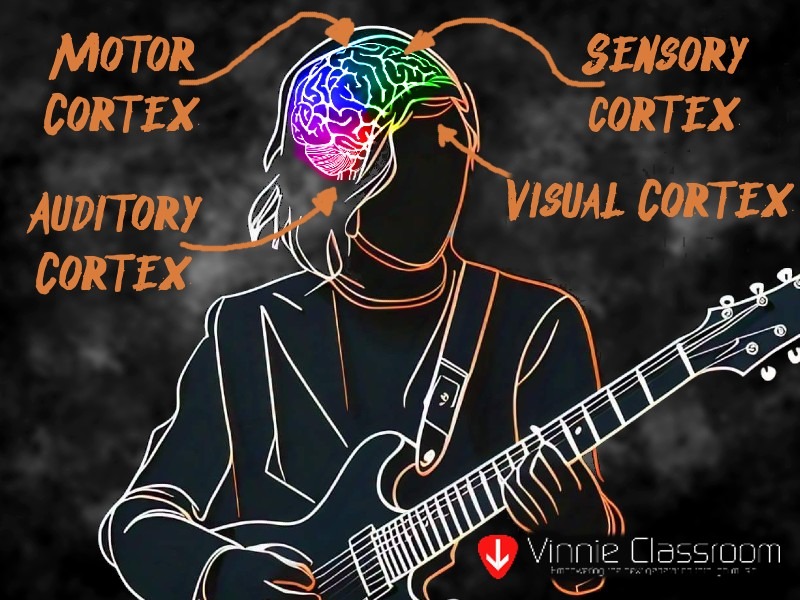Music Lessons makes us Superhumans!
Playing music is more than just a pleasurable pastime, music lessons makes us superhumans! It’s an incredible workout for your brain. From the release of endorphins to the enhancement of cognitive functions, engaging in music playing has numerous mental benefits that go far beyond listening. Let’s dive into how this activity impacts our brain, and why it’s so beneficial.
Getting Endorphins Through Music
One of the immediate effects of playing music is the release of endorphins, often referred to as “feel-good” chemicals. Endorphins are hormones produced by the brain to help relieve pain, reduce stress, and enhance feelings of pleasure. When you play an instrument, whether it’s strumming a guitar or pounding the drums, your brain rewards you with these mood-boosting chemicals. This natural high can alleviate anxiety, reduce feelings of depression, and create a sense of accomplishment. Music-making is not just a cognitive task—it’s emotionally therapeutic.
One of the best examples would be Music therapy. It harnesses the healing power of music to improve mental, emotional, and physical well-being. Through personalized interventions, such as listening, playing, or composing music, this therapy helps individuals manage stress, reduce anxiety, and cope with trauma. It is particularly effective in enhancing emotional expression, fostering communication, and aiding in cognitive rehabilitation for conditions like stroke, Alzheimer’s, and PTSD. Music therapy also stimulates the brain’s reward centers, promoting relaxation and endorphin release, which can alleviate pain and improve mood. Its non-verbal nature makes it a versatile tool for reaching individuals of all ages and abilities, providing comfort, connection, and healing.
Music Lessons: A Superhuman Workout for the Brain
Playing music isn’t a simple, passive activity. It engages multiple areas of the brain simultaneously, making it a full mental workout. For instance, musicians must read and interpret music, maintain rhythm, control fine motor movements, and adjust their emotional expression—all while coordinating with other musicians or listeners. Each of these tasks activates different regions of the brain, from the auditory cortex (processing sound) and the motor cortex (coordinating movement) to the visual cortex (processing visual cues, such as reading sheet music) and the sensory cortex (interpreting tactile feedback from playing an instrument). This synchronized activity sharpens both hemispheres of the brain, enhancing creativity, logical thinking, spatial awareness, and sensory-motor integration.
Playing Music vs. Listening to Music: Fine Motor Skills Matter
While listening to music can evoke emotional responses and stimulate the brain, playing music takes the experience to a whole new level. The active involvement of fine motor skills—like pressing piano keys or plucking guitar strings—requires detailed hand-eye coordination. This physical engagement strengthens neural pathways in the brain that are associated with movement, sensory perception, and timing. Moreover, the practice and repetition involved in playing an instrument help improve dexterity and precision, fine-tuning the brain’s ability to handle complex tasks. Listening to music can certainly stimulate the mind, but playing it actively shapes the brain in ways passive listening cannot.
Music Lessons Strengthen the Brain for Tackling Other Problems
Learning to play an instrument doesn’t just make you a better musician—it enhances your ability to solve problems in other areas of life. Studies have shown that music lessons improve critical thinking, memory, and the ability to plan ahead. This happens because music demands pattern recognition, multitasking, and the ability to focus on details while keeping track of the bigger picture—all of which are transferable skills. The discipline and patience developed through regular practice also build resilience, making it easier to tackle academic or professional challenges. In essence, learning to play music strengthens the brain’s overall problem-solving capabilities.

Music Playing Engages Both Sides of the Brain: Critical Thinking and Creativity
One of the unique aspects of music playing is how it activates both hemispheres of the brain simultaneously. The left hemisphere, which is responsible for logic, analysis, and critical thinking, is engaged when a musician reads sheet music, keeps time, and follows musical structure. On the other hand, the right hemisphere, known for creativity, emotional expression, and imagination, is activated as musicians interpret and feel the music, add personal expression, and improvise. This balanced brain engagement enhances cognitive flexibility and strengthens connections between the two hemispheres, making musicians more adept at switching between logical and creative tasks in daily life.
:max_bytes(150000):strip_icc()/MIND-Left-Brain-Right-Brain-560318488e7b40c6a0093036ed4fd1f5.jpg)
Conclusion
The mental benefits of playing music are vast, from the emotional highs provided by endorphins to the full brain workout that comes with the intricate tasks involved in musicianship. While listening to music can soothe the soul, playing it engages your brain in a way that enhances cognitive function, fine motor skills, and brain hemispheric balance. By strengthening neural connections, music lessons can even improve your ability to handle non-musical problems more efficiently. The next time you pick up your instrument, remember—you’re not just making music, you’re also working out your brain in ways that will benefit you for a lifetime.
Don’t take our word for it, take a Trial Lesson with us!
Contact us if you wish to find out more! 🙂








Join the discussion One Comment